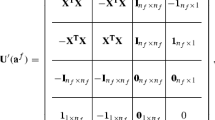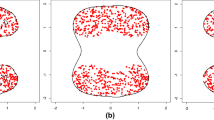Abstract
This paper presents a methodology for constrained efficient global optimization (EGO) using support vector machines (SVMs). While the objective function is approximated using Kriging, as in the original EGO formulation, the boundary of the feasible domain is approximated explicitly as a function of the design variables using an SVM. Because SVM is a classification approach and does not involve response approximations, this approach alleviates issues due to discontinuous or binary responses. More importantly, several constraints, even correlated, can be represented using one unique SVM, thus considerably simplifying constrained problems. In order to account for constraints, this paper introduces an SVM-based “probability of feasibility” using a new Probabilistic SVM model. The proposed optimization scheme is constituted of two levels. In a first stage, a global search for the optimal solution is performed based on the “expected improvement” of the objective function and the probability of feasibility. In a second stage, the SVM boundary is locally refined using an adaptive sampling scheme. An unconstrained and a constrained formulation of the optimization problem are presented and compared. Several analytical examples are used to test the formulations. In particular, a problem with 99 constraints and an aeroelasticity problem with binary output are presented. Overall, the results indicate that the constrained formulation is more robust and efficient.


























Similar content being viewed by others
References
Alexandrov NM, Lewis RM, Gumbert CR, Green LL, Newman PA (2001) Approximation and model management in aerodynamic optimization with variable-fidelity models. J Aircr 38(6):1093–1101
Arenbeck H, Missoum S, Basudhar A, Nikravesh PE (2010) Reliability-based optimal design and tolerancing for multibody systems using explicit design space decomposition. J Mech Des 132(2):021010
Audet Jr C, Dennis JE, Moore DW, Booker A, Frank PD (2000) A surrogate based method for constrained optimization. In: 8th AIAA/NASA/USAF/ISSMO symposium on multidisciplinary analysis and optimization. Paper number AIAA-2000-4891
Basudhar A, Missoum S (2008) Adaptive explicit decision functions for probabilistic design and optimization using support vector machines. Comput Struct 86(19–20):1904–1917
Basudhar A, Missoum S (2009) A sampling-based approach for probabilistic design with random fields. Comput Methods Appl Mech Eng 198(47-48):3647–3655
Basudhar A, Missoum S (2010) An improved adaptive sampling scheme for the construction of explicit boundaries. Struct Multidisc Optim 42(4):517–529
Basudhar A, Missoum S, Harrison Sanchez A (2008) Limit state function identification using support vector machines for discontinuous responses and disjoint failure domains. Probab Eng Mech 23(1):1–11
Bichon BJ (2010) Efficient surrogate modeling for reliability analysis and design. PhD thesis, Vanderbilt University
Bichon BJ, Mahadevan S, Eldred MS (2009) Reliability-based design optimization using efficient global reliability assessment. In: Proceedings of the 50th AIAA/ASME/ASCE/AHS/ASC on structures, dynamics and materials conference. Paper AIAA-2009-2264. Palm Springs, California
Chiles JP, Delfiner P (1999) Geostatistics: modeling spatial uncertainty. Wiley-Interscience, New York
Cressie N (1990) The origins of Kriging. Math Geol 22(3):239–252
Cristianini N, Shawe-Taylor J (2006) An introduction to support vector machines: and other kernel-based learning methods. Cambridge University Press, Cambridge
Forrester AIJ, Keane AJ (2009) Recent advances in surrogate-based optimization. Prog Aerosp Sci 45(1–3):50–79
Forrester AIJ, Sobester A, Keane AJ (2008) Engineering design via surrogate modelling: a practical guide. Wiley, New York
Ginsbourger D, Le Riche R, Carraro L (2007) A multi-points criterion for deterministic parallel global optimization based on Kriging. In: International conference on nonconvex programming, NCP07
Gramacy RB, Lee HKH (2010) Optimization under unknown constraints. Arxiv preprint, arXiv:1004.4027
Gunn SR (1998) Support vector machines for classification and regression. Technical Report ISIS-1-98, Department of Electronics and Computer Science, University of Southampton
Henkenjohann N, Kunert J (2007) An efficient sequential optimization approach based on the multivariate expected improvement criterion. Qual Eng 19(4):267–280
Huang D, Allen TT, Notz WI, Miller RA (2006) Sequential Kriging optimization using multiple-fidelity evaluations. Struct Multidisc Optim 32(5):369–382
Jin R, Du X, Chen W (2003) The use of metamodeling techniques for optimization under uncertainty. Struct Multidisc Optim 25(2):99–116
Jones DR, Schonlau M, Welch WJ (1998) Efficient global optimization of expensive black-box functions. J Glob Optim 13(4):455–492
Kleijnen JPC (2009) Kriging metamodeling in simulation: a review. Eur J Oper Res 192(3):707–716
Lee H, Gramacy R, Linkletter C, Gray G (2010) Optimization subject to hidden constraints via statistical emulation. Technical report, Tech Rep UCSC-SOE-10-10, University of California, Santa Cruz, Department of Applied Mathematics and Statistics
Lin HT, Lin CJ, Weng RC (2007) A note on Platt’s probabilistic outputs for support vector machines. Mach Learn 68(3):267–276
Martin JD, Simpson TW (2005) Use of Kriging models to approximate deterministic computer models. AIAA J 43(4):853–863
Missoum S, Ramu P, Haftka RT (2007) A convex hull approach for the reliability-based design of nonlinear transient dynamic problems. Comput Methods Appl Mech Eng 196(29):2895–2906
Picheny V, Kim NH, Haftka RT, Queipo NV (2008) Conservative predictions using surrogate modeling. In: Proceedings of the 49th AIAA/ASME/ASCE/AHS/ASC structures, structural dynamics, and materials conference, Schaumburg, Illinois, USA, pp 7–10
Platt JC (1999) Probabilistic outputs for support vector machines and comparisons to regularized likelihood methods. In: Advances in large margin classifiers. MIT Press, Cambridge, pp 61–74
Ponweiser W, Wagner T, Vincze M (2008) Clustered multiple generalized expected improvement: a novel infill sampling criterion for surrogate models. In: IEEE congress on evolutionary computation, Hong Kong
Queipo NV, Haftka RT, Shyy W, Goel T, Vaidyanathan R, Tucker PK (2005) Surrogate-based analysis and optimization. Prog Aerosp Sci 41(1):1–28
Rasmussen CE, Williams CKI (2005) Gaussian processes for machine learning
Santner TJ, Williams BJ, Notz W (2003) The design and analysis of computer experiments. Springer, New York
Sasena MJ (2002) Flexibility and efficiency enhancements for constrained global optimization with Kriging approximations. PhD thesis, Department of Mechanical Engineering, University of Michigan, Ann Arbor, MI
Sasena MJ, Papalambrose PY, Goovaerts P (2002a) Exploration of metamodeling sampling criteria for constrained global optimization. Eng Optim 34:263–278
Sasena M, Papalambros P, Goovaerts P (2002b) Global optimization of problems with disconnected feasible regions via surrogate modeling. In: 9th AIAA/ISSMO symposium on multidisciplinary analysis and optimization. Citeseer
Scholkopf B, Smola AJ (2002) Learning with kernels: support vector machines, regularization, optimization, and beyond. MIT Press, Cambridge
Schonlau M (1997) Computer experiments and global optimization. PhD thesis, Department of Statistics, University of Waterloo, Ontario, Canada
Simpson TW, Toropov VV, Balabanov VO, Viana FAC (2008) Design and analysis of computer experiments in multidisciplinary design optimization: a review of how far we have come—or not. In: 12th AIAA/ISSMO multidisciplinary analysis and optimization conference, Victoria, British Colombia, Canada
Stein ML (1999) Interpolation of spatial data: some theory for Kriging. Springer, New York
Vanderplaats Research & Development, Inc (2006) Genesis analysis manual version 9.0
Vapnik VN (1998) Statistical learning theory. Wiley, New York
Viana FAC, Gogu C, Haftka RT (2010a) Making the most out of surrogate models: tricks of the trade. In: ASME 2010 international design engineering technical conferences & computers and information in engineering conference, Montreal, Canada
Viana F, Haftka R, Watson LT (2010b) Why not run the efficient global optimization algorithm with multiple surrogates? In: Proceedings of the 51th AIAA/ASME/ASCE/AHS/ASC structures, structural dynamics, and materials conference, AIAA, Orlando, FL, USA. AIAA–2010–3090
Wang GG, Shan S (2007) Review of metamodeling techniques in support of engineering design optimization. J Mech Des 129(4):370–380
Zona Technology, Inc (2008) Zaero version 8.3 theoretical manual, 19th edn
Acknowledgments
The support of the National Science Foundation (award CMMI-1029257) and the partial support of the Air Force Office of Scientific Research (Grant FA9550-10-1-0353) is gratefully acknowledged. We are also thankful to Dr. Jean–Marc Bourinet (Institut Français de Mécanique Avancée, France) for sending Sylvain Lacaze as an exchange student.
Author information
Authors and Affiliations
Corresponding author
Appendices
Appendix A: Effect of the design of experiments size
This section presents an example of the effect of initial design of experiments on the optimization results, for Example 2 (Section 5.2). Three sets of initial DOEs are used, consisting of 5, 10 and 15 CVT samples to run the optimization. The percentage relative errors in the objective function value ϵ k are plotted in Fig. 27 for the three cases. The constrained formulation (update scheme 2) is used. It is seen that for all the cases, the optimization converges within 21 iterations.
Appendix B: Two constraint problem
This appendix provides another analytical example. The constrained and unconstrained formulations are compared. The example is taken from Sasena (2002), and consists of two variables x 1 and x 2 in the range [ − 2, 2]. The feasible space for this problem is bounded by two constraints. The optimization problem is:
The objective function, the constraints and the optimum solution are depicted in Fig. 28. The actual optimum is at (0.5955, − 0.4045) with an objective function value of 289.85.
Appendix B example. Individual constraints and the resulting feasible and infeasible regions (left). Objective function contours, boundary of feasible space and the the optimum solution (right)
The initial error with 10 CVT samples is 261.0%. The evolution of ϵ k using the unconstrained and constrained formulations are plotted in Figs. 29 and 30. In order to check the consistency of the results, the algorithm was run 50 times. The mean, median, minimum and maximum errors are provided.
Appendix B example. Evolution of ϵ k with unconstrained formulation. 50 runs
Appendix B example. Evolution of ϵ k with constrained formulation. 50 runs
As a comparison, this example was also run using a purely Kriging-based approach where the two constraints are also approximated by Kriging. As described in Schonlau (1997) and Forrester et al. (2008), the approach is based on the product of EI times the probabilities of feasibility of each constraint (EI(x) P(g 1(x) ≤ 0) P(g 2(x) ≤ 0)). The run was carried out using a freely available online code (Forrester et al. 2008). The statistics of results based on 50 runs are gathered in Fig. 31. It is observed that in the SVM-based unconstrained approach as well as the purely Kriging-based approach, the optimization does not always converge accurately to the optimum. This is clearly demonstrated on Figs. 29 and 31. This is likely due to the fact that the gradient of the objective function is quite large around the optimum. On the other hand, the SVM-based constrained formulation (Fig. 30) does consistently reach the optimum accurately.
Evolution of ϵ k using A. Forrester’s code (Forrester et al. 2008). 50 runs
Rights and permissions
About this article
Cite this article
Basudhar, A., Dribusch, C., Lacaze, S. et al. Constrained efficient global optimization with support vector machines. Struct Multidisc Optim 46, 201–221 (2012). https://doi.org/10.1007/s00158-011-0745-5
Received:
Revised:
Accepted:
Published:
Issue Date:
DOI: https://doi.org/10.1007/s00158-011-0745-5









